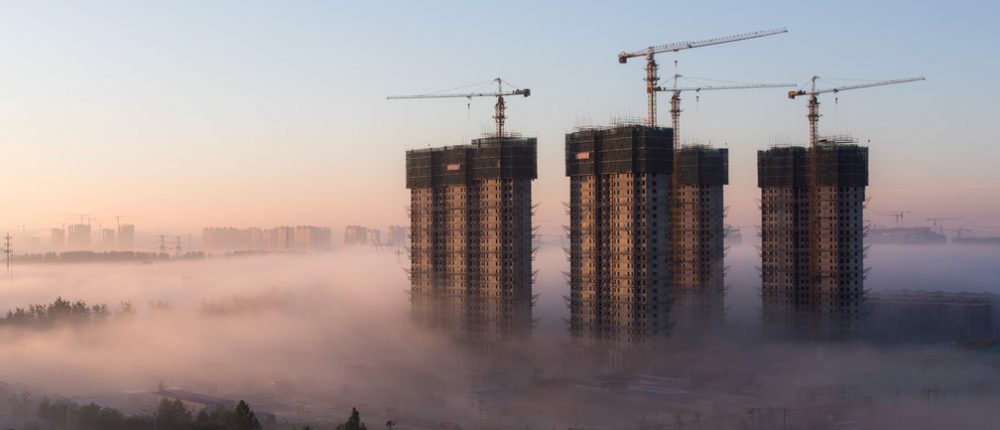China - clean, green buildings of the future
China is the largest building construction market in the world, with up to 2 billion sq. m constructed annually, accounting for nearly half of new construction globally in the coming decade.
In 2011, buildings accounted for just 28% of China’s energy consumption, but urbanisation, economic growth and rising population could increase this number by as much as 40% over the next 15 years. The adoption of green building technologies and solutions is a key part of China’s sustainability and environmental protection goals.
China’s 13th Five Year Plan for Building Energy Efficiency and Green Building Development includes aggressive goals for green building construction and renovation, including a requirement for 50% of all new urban buildings to be certified green buildings. The plan also specifies pilot programmes for constructing and renovating energy efficient primary and secondary schools, community hospitals and public buildings.
As the national Five Year Plan is cascaded to provincial and municipal jurisdictions, nearly 20 cities have set even more ambitious targets. For example, Changde, Zhenjiang, Zibo, Wuxi, and Suzhou, Shanghai, Beijing, Shenzhen, and Chongqing will require all new commercial buildings to be green buildings. In the pursuit of even more sustainable buildings, more than 90% of China’s commercial building owners plan to have at least one net or near-zero energy building in the next ten years.
National plans, policies and targets are important drivers of investment and improvement. Still, significant challenges remain in implementation at a city and district level, such as training, business models, financial solutions and access to information.
Public-private partnerships continue to be one of the most effective ways of overcoming these barriers. The East Asia launch of the Building Efficiency Accelerator (BEA), a global public-private partnership coordinated by the World Resources Institute (WRI), was held at the Thirteenth International Conference on Green and Energy-Efficient Building in Beijing.
The launch included government, private-sector and civil society stakeholders and showcased the building efficiency policy best practices of three leading Chinese districts – Changning District, Wuxi City High-Tech Industrial Development Zone and Suzhou Taihu New City, as well as the BEA partner cities of Ulaanbaatar, Mongolia and Iskandar, Malaysia.
The Changning District deployed an energy monitoring platform that now tracks 160 of the district’s 165 public buildings. To date, 32 buildings have been retrofitted to achieve an average 20% energy saving. The district also provided subsidies to building managers, which in turn encouraged building managers to invest an additional 140 million yuan (US$20.33 million) to improve building efficiency.
Wuxi City High-Tech Industrial Development Zone provided incentives for new buildings that are certified to the US Green Building Council’s LEED or China’s national three-star rating systems. Buildings that achieve the highest green building ratings in either certification program receive up to 500,000 yuan with similar incentives provided for the use of heat pumps, solar photovoltaic systems, and other clean energy technologies.
The Suzhou Taihu New City will house 200,000 residents and all buildings will be designed to receive at least a two-star rating from China’s three-star rating system. The city will also boast a green building demonstration area, constructing several projects like zero-energy schools and monitoring of the building’s energy performance.
Another important public-private partnership is the US-China CERC Building Energy Efficiency (CERC-BEE) consortium. This is a collaborative partnership between leading US and Chinese researchers at national laboratories, research institutes, universities and 48 industry partners, to advance the state-of-the-art in low-carbon and near zero energy buildings.
The new Johnson Controls Headquarters Asia Pacific will be a living laboratory for the company’s CERC-BEE research activities focused on advanced energy monitoring and control, indoor air quality management and building-to-grid integration. Finally, the facility will be used to convene public roundtables and forums to share industry best practices that can help local and provincial governments in China and across the region accelerate their urban efficiency initiatives.
As cities grow, those of us in the buildings space – be it the public or private sector – have an obligation to work together to implement green building technologies and solutions. It’s an effective solution to rising concerns over sustainability and environmental protection, particularly in high-growth markets like China.
This article was written by Alex Molinaroli, Chairman and CEO, Johnson Controls, is a Co-Chair of the Annual Meeting of the New Champions 2017.
Please find the original article here
--Future of Construction 14:13, 04 Jul 2017 (BST)
[edit] Related articles on Designing Buildings Wiki
- 3 ways the fastest growing economies can close the infrastructure gap.
- BRE China celebrates two major milestones.
- China’s New Silk Road - what you need to know.
- Chinese Wallpaper in Britain and Ireland.
- Green building.
- Leadership in Energy and Environmental Design LEED.
- Sustainability in building design and construction.
- These giant infrastructure projects are set to reshape Africa.
- Top 4 challenges facing the construction industry.
- Why the West has to join the Belt and Road Initiative.
Featured articles and news
International Electrician Day, 10 June 2025
Celebrating the role of electrical engineers from André-Marie Amperè, today and for the future.
New guide for clients launched at Houses of Parliament
'There has never been a more important time for clients to step up and ...ask the right questions'
The impact of recycled slate tiles
Innovation across the decades.
EPC changes for existing buildings
Changes and their context as the new RdSAP methodology comes into use from 15 June.
Skills England publishes Sector skills needs assessments
Priority areas relating to the built environment highlighted and described in brief.
BSRIA HVAC Market Watch - May 2025 Edition
Heat Pump Market Outlook: Policy, Performance & Refrigerant Trends for 2025–2028.
Committing to EDI in construction with CIOB
Built Environment professional bodies deepen commitment to EDI with two new signatories: CIAT and CICES.
Government Grenfell progress report at a glance
Line by line recomendation overview, with links to more details.
An engaging and lively review of his professional life.
Sustainable heating for listed buildings
A problem that needs to be approached intelligently.
50th Golden anniversary ECA Edmundson apprentice award
Deadline for entries has been extended to Friday 27 June, so don't miss out!
CIAT at the London Festival of Architecture
Designing for Everyone: Breaking Barriers in Inclusive Architecture.
Mixed reactions to apprenticeship and skills reform 2025
A 'welcome shift' for some and a 'backwards step' for others.
Licensing construction in the UK
As the latest report and proposal to licence builders reaches Parliament.
Building Safety Alliance golden thread guidance
Extensive excel checklist of information with guidance document freely accessible.
Fair Payment Code and other payment initiatives
For fair and late payments, need to work together to add value.
Pre-planning delivery programmes and delay penalties
Proposed for housebuilders in government reform: Speeding Up Build Out.
High street health: converting a building for healthcare uses
The benefits of health centres acting as new anchor sites in the high street.


























